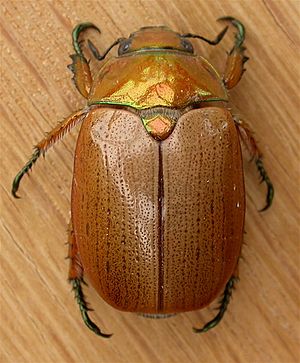Brown- facts for kids
Quick facts for kids Brown- |
|
|---|---|
 |
|
| Scientific classification | |
| Synonyms | |
|
The brown Christmas beetle or golden-brown Christmas beetle (scientific name: Anoplognathus chloropyrus) is a type of beetle. It belongs to the Scarabaeidae family. You can find these beetles in eastern Australia, especially along the coasts of Queensland, New South Wales, and Victoria. They also live in the Great Dividing Range and the Murray-Darling river basin.
Discovering the Christmas Beetle
A scientist from Belgium named Auguste Drapiez first described this beetle in 1819. He called it Rutela chloropyra. Drapiez noted that the beetle was found in Australia during the summer. Later, in 1835, a French scientist named Jean Baptiste Boisduval described a similar beetle. He named it Anoplognathus nitidulus.
However, in 1873, another scientist, William John Macleay, realized that Boisduval's beetle was actually the same as the one Drapiez had found. So, Anoplognathus nitidulus became a synonym, meaning it was another name for the same species. Over time, the beetle's name was sometimes misspelled as chloropygus.
What Does It Look Like?
As its common name suggests, the golden-brown Christmas beetle has a yellow or biscuit-brown color. It often has a shiny green or gold-red glow. The beetle's body parts, like its abdomen and thorax, are green and covered with tiny white hairs.
Adult male beetles are usually between 19 and 23 millimeters long. Female beetles are a bit bigger, measuring 21 to 26 millimeters in length.
What Do Christmas Beetles Eat?
Like many of its relatives, the brown Christmas beetle has strong jaws. These jaws are perfect for chewing on tough leaves from Eucalyptus trees. Sometimes, these beetles can eat so many leaves that they strip entire trees bare. This can be a problem for eucalyptus tree farms.
The brown Christmas beetle is considered a pest in eucalyptus plantations in Victoria and New South Wales. They especially like to eat leaves from certain types of eucalyptus trees. These include Tasmanian blue gum (Eucalyptus globulus), manna gum (E. viminalis), and shining gum (E. nitens). They also feed on flooded gum (E. grandis), white gum (E. dunnii), mountain white gum (E. dalrympleana), and broad-leaved peppermint (E. dives).
Interestingly, they rarely eat Sydney blue gum (E. saligna) and completely ignore blackbutt (E. pilularis). Studies have shown that these beetles prefer to eat leaves that are not too new and not too old. They also tend to feed on trees that are taller than 2.5 meters. To help protect tree farms, some types of E. grandis trees have been grown to be less tasty to these beetles.

